At different times, in different places, the conscious entity, which I perceive to be "me", can be in various states. For example, it can be happy, sad, excited, apprehensive, fearful, depressed, elated. These are what I call states of consciousness. They are no doubt triggered by events emanating from the outside world that are detected by my physical senses to create physiological events within my brain. These, in turn, give rise to conscious experiences, which themselves determine, or at least influence, my state of consciousness at any particular time.
The conscious experiences, to which I am referring, originate from sensory inputs from the outside world. My sense of vision gives me the conscious experiences of light and colour. My sense of sound gives me the conscious experiences of pitch and tone. My sense of taste gives me the conscious experiences of bitterness and sweetness. My sense of smell gives me conscious experiences of scents and odours. My sense of touch gives me the conscious experiences of texture, wetness, dryness, heat, cold, pain, eroticism and orgasm. Underlying all these is my sense of space and time.
I perceive my life as an event. It had a beginning. It is now in progress. One day it will end. My life is made up of what appear to be component events — things that happen during my life. They give character and detail to my life. But they are not really isolated from each other. They form a complex dynamical continuum of change linked by what I perceive as cause and effect. It is this continuum of change that gives me my sensation of existing within space and time.
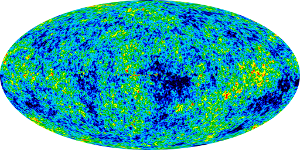 I further perceive that the composite event that is my life is similarly linked to all other events that are taking place within the physical universe. My life is thus a component event of the universe. I therefore conclude that the physical universe itself is an event. It must be the all-encompassing event that comprises all others.
I further perceive that the composite event that is my life is similarly linked to all other events that are taking place within the physical universe. My life is thus a component event of the universe. I therefore conclude that the physical universe itself is an event. It must be the all-encompassing event that comprises all others.
By definition, the universe comprises everything that is linked together to form a whole. It is a single object. It is one continuous piece of space-time fabric within which all else is merely a complex dynamical turmoil of standing and travelling waves that are borne within this fabric. This makes the universe rather special because it must be the one event that interacts with no other. It has no coupling with anything outside itself. If it did, then whatever it was coupled with would, by definition, be a part of it.
What makes the universe an event is its propensity for constant change. Its parts are constantly changing form and relative position. Galaxies move relative to each other. They emit vast amounts of energy in the form of travelling waves such as electromagnetic and gravitational radiation. Their individual stars do the same. Even the matter that has fallen into a black hole is still part of the universe. If even an electron falls into a black hole, the black hole acquires an increase in mass. This causes its gravitational field to increase by the emission of a gravitational wave, which informs the rest of the universe of the event.
At the smallest scale there are stable standing-wave structures like molecules, atoms, electrons, protons and coupled neutrons. The existence of such a structure can be intimated to a sentient being like myself only if and when it changes its velocity relative to me or changes its internal configuration. This is because it is only then that it emits a travelling wave. And only a travelling wave can carry information to me and thereby, however indirectly, enable me to experience its presence.
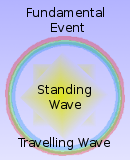 Furthermore, molecules, atoms, electrons, protons and neutrons themselves are now thought to be complex dynamical systems in their own right. These must therefore comprise even smaller structures, whose spontaneous changes in velocity or internal configuration precipitate events that are even more basic. I speculate that there must be an indivisible (or unanalysable) event that underlies all others. It is the fundamental constituent of the universe. It occurs when an instance of the fundamental standing wave structure changes into a fundamental travelling wave, which travels outwards from it at the speed of light.
Furthermore, molecules, atoms, electrons, protons and neutrons themselves are now thought to be complex dynamical systems in their own right. These must therefore comprise even smaller structures, whose spontaneous changes in velocity or internal configuration precipitate events that are even more basic. I speculate that there must be an indivisible (or unanalysable) event that underlies all others. It is the fundamental constituent of the universe. It occurs when an instance of the fundamental standing wave structure changes into a fundamental travelling wave, which travels outwards from it at the speed of light.
I see the fundamental standing-wave structure as a fundamental unit of energy held in rotational form. All its rest-mass energy is conserved within a small volume of space-time that has a sub-light velocity relative to the rest of the universe. When this transmutes into a travelling wave, however, its energy spreads outwards into the universe as an ever-expanding sphere whose radius increases at the speed of light. Consequentially, the amount of its energy capturable at any locality on the surface of the expanding sphere becomes ever smaller. Besides, right from the beginning, it will be less than the fundamental unit of energy that was held in the original standing-wave structure, so it is essentially uncapturable. Nevertheless, there is an astronomical number of fundamental events taking place in the universe all the time. In some locations the composite energy of many such expanding spherical waves will reinforce to carry the local energy flux above the fundamental level. In such places, this will be enough to create new fundamental standing-wave structures.
I speculate that the spontaneous exploding of fundamental standing wave structures into travelling event waves and the spontaneous re-crystallisation of multiple event waves into standing wave structures is what underlies all the interactive variety that I perceive and experience the universe to be. The big question is: how do I perceive and experience it all? Do the processes of my perception and experience comprise these fundamental events? Or are the processes of my perception and experience outside the dimensions of the physical universe?
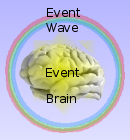 I feel sure that my brain is a purely physical device. It is vast. I am given to understand that it is currently thought to comprise about 86 billion neurons It is an immensely powerful information processing engine, comprising massively parallel networks of neurons of various specialised architectures. But since it is physical, the very foundation of its function must involve the initiation and detection of fundamental events. So, are some of these events, that are taking place within the depths of my brain, the essence of my conscious experience?
I feel sure that my brain is a purely physical device. It is vast. I am given to understand that it is currently thought to comprise about 86 billion neurons It is an immensely powerful information processing engine, comprising massively parallel networks of neurons of various specialised architectures. But since it is physical, the very foundation of its function must involve the initiation and detection of fundamental events. So, are some of these events, that are taking place within the depths of my brain, the essence of my conscious experience?
I find it hard to believe that a physical event, no matter how fundamental it may be, could be a conscious experience. I think such a physical event could, through some mysterious means, trigger or invoke a conscious experience. Conversely, I cannot see a conscious experience as being a physical event.
Perhaps it is a matter of scale. A real conscious experience comprises sensations and feelings that pertain to events on a macroscopic scale. They are events on the human scale rather than events on a sub-atomic scale. Real conscious experiences therefore are experiences provoked by complex-dynamical events involving a statistically large number of sub-atomic events. This is what gives them the intricate detail and character that makes them worthy of conscious consideration. It is what makes them beautiful or awesome. A conscious experience of a sub-atomic event would be bland, boring and identical, and hence totally uninspiring.
However, the fact that a real experience is so rich in detail suggests that the channel through which it receives this detail, from the physical event that invokes it, must have an enormous bandwidth. The link between event and experience must therefore comprise an astronomical number of fundamental events taking place in parallel. It is reasonable to suppose, therefore, that the connection between physical event and conscious experience must be at the fundamental level.
It follows that there must be some kind of coupling between fundamental physical events on the one side and the constituent elements of a conscious experience on the other side. When there is any form of coupling or linkage between two events or processes, the interaction is always two-way. The coupling may be very strong or it may be very weak, or anywhere in between.

The primary and secondary coils of an electrical transformer are strongly coupled by the magnetic core of the transformer. When an appliance is connected to the secondary coil, it passes back its load to the primary coil that is connected to the electricity supply.
 On the other hand, the coupling between a radio transmitting aerial and a receiving aerial 30 km away is very weak. But it exists. When the receiving aerial captures the signal, it loads the distant transmitting aerial by changing its impedance slightly. It may not be easy or even possible to measure it. But proven theory says that it is there.
On the other hand, the coupling between a radio transmitting aerial and a receiving aerial 30 km away is very weak. But it exists. When the receiving aerial captures the signal, it loads the distant transmitting aerial by changing its impedance slightly. It may not be easy or even possible to measure it. But proven theory says that it is there.
But what about the coupling between, on the one hand, a fundamental event taking place within my brain and, on the other hand, the fundamental element of experience that it invokes within my consciousness.
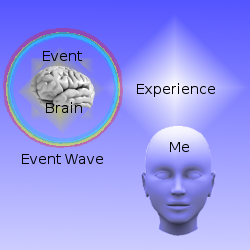 How are they connected? Is the connection (or influence) one-way or two-way? And how strong (or tight) is this coupling? Does experience absorb the energy of a fundamental event? If so, then assuming that conscious experience be hyper-physical, that energy would exit the physical universe. Does conscious experience induce a reactive load back upon the physical event that invokes it? In other words, does experiencing an event modify that event? The sheer volume of information that is transferred from a physical event to my experience of that event appears to be enormous.
How are they connected? Is the connection (or influence) one-way or two-way? And how strong (or tight) is this coupling? Does experience absorb the energy of a fundamental event? If so, then assuming that conscious experience be hyper-physical, that energy would exit the physical universe. Does conscious experience induce a reactive load back upon the physical event that invokes it? In other words, does experiencing an event modify that event? The sheer volume of information that is transferred from a physical event to my experience of that event appears to be enormous.
On the other hand, the influence that my experience has upon the event that invoked it seems to be non-existent.
 There is clearly no "equal and opposite reaction". Whatever it is that provides the connection between an event and the conscious experience of it, it appears to be a one-way street like an electronic diode, which allows current to flow in the forward direction but not in the reverse direction.
There is clearly no "equal and opposite reaction". Whatever it is that provides the connection between an event and the conscious experience of it, it appears to be a one-way street like an electronic diode, which allows current to flow in the forward direction but not in the reverse direction.
My intuition is that a conscious experience does not sap any energy from the physical event that inspires it. I tend towards the idea that physical energy is conserved within the physical universe. So, perhaps the essence of a physical event that I experience is transmitted to the conscious entity that is "me" by some exotic counterpart of energy.
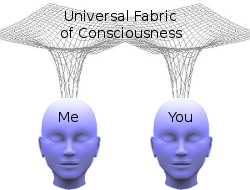 Some think that the universe has a conscious dimension — a kind of conscious equivalent of space-time. A fundamental event within my brain would thus emit not only a spherical wave of physical energy, but also a hyper-physical wave of conscious influence. So, waves emanating from an experience I am having will travel outwards as a hyper-physical wave. This wave must eventually reach and impinge upon your consciousness, directly imparting to you an experience of the experience I am having, independently of any physical medium.
Some think that the universe has a conscious dimension — a kind of conscious equivalent of space-time. A fundamental event within my brain would thus emit not only a spherical wave of physical energy, but also a hyper-physical wave of conscious influence. So, waves emanating from an experience I am having will travel outwards as a hyper-physical wave. This wave must eventually reach and impinge upon your consciousness, directly imparting to you an experience of the experience I am having, independently of any physical medium.
I find this idea difficult. There is no tangible evidence that molecules, atoms, electrons, protons and bound neutrons may contain anything hyper-physical that can influence a conscious entity directly. What can be asserted, however, is that instances of one person's consciousness directly experiencing another person's conscious experience is sufficiently diminishingly uncommon to justifiably put it down to wishful thinking.
Experience itself shows that self-aware conscious entities, like I perceive myself to be, each exist in mutual isolation. There is no direct conscious connection between them. This means that there is no universe of consciousness. At least, there isn't one to which human beings, in their present physical state of being, have access.
 The only channel through which human conscious entities can be aware of each other is via the 5 physical senses of their physical bodies acting through the physical world. In other words, I can experience you only via the physical universe. My consciousness cannot communicate with your consciousness directly by propagating waves through a conscious counterpart of the fabric of space-time. Consequently, there must be some sort of mysterious communication interface between fundamental physical events and the conscious entity that I perceive to be "me". And it must be located somewhere within my brain. Perhaps the active elements of this interface directly monitor fundamental events taking place within my neurons or inter-neural pathways. Perhaps my consciousness somehow captures a macroscopic statistical view of a thought. I don't know. Neither do I know the nature of what passes across this communications interface.
The only channel through which human conscious entities can be aware of each other is via the 5 physical senses of their physical bodies acting through the physical world. In other words, I can experience you only via the physical universe. My consciousness cannot communicate with your consciousness directly by propagating waves through a conscious counterpart of the fabric of space-time. Consequently, there must be some sort of mysterious communication interface between fundamental physical events and the conscious entity that I perceive to be "me". And it must be located somewhere within my brain. Perhaps the active elements of this interface directly monitor fundamental events taking place within my neurons or inter-neural pathways. Perhaps my consciousness somehow captures a macroscopic statistical view of a thought. I don't know. Neither do I know the nature of what passes across this communications interface.
Nevertheless, I do know that what passes from the physical to the consciousness across this interface is not the experience itself. Neither does it bare any significant resemblance to the experience it invokes. Physical events inspire experiences, but they do not generate them. What I experience is generated internally by my consciousness. It is the self-aware conscious entity that is "me" which generates an experience in response to a physical event. This is evinced by the fact that an experience contains elements and dimensions that are nowhere present in the physical event that inspires it. I shall illustrate this assertion by exploring in detail the experience, created within my consciousness, by light emanating from a scene in front of my eyes. Specifically, I shall consider my experience of colour.
Light comprises electromagnetic waves with wavelengths in a range from 750nm down to 380nm. The abbreviation "nm" stands for "nanometre", which is a thousandth of a millionth of a metre. This range of wavelengths corresponds to a frequency range from 400THz up to 790THz. The abbreviation "THz" stands for "terahertz", which is one million million Hertz (one Hertz is one cycle — or one complete polarity reversal and back again — per second). As wavelengths get smaller, frequency increases.
| Violet | 400 | 750
|
| Indigo | 445 | 674
|
| Blue | 475 | 632
|
| Green | 510 | 588
|
| Yellow | 570 | 526
|
| Orange | 590 | 508
|
| Red | 650 | 462
|
Within the range of visible light, different sub-ranges of wavelengths or frequencies produce what I perceive to be different colours. The wavelength and frequency at the centre of the sub-range for each colour is shown in the table on the left. However, within the context of this essay, it is vitally important to be aware that there is absolutely nothing "coloured" about these sub-ranges of the visible part of the electromagnetic spectrum. Colour is
not in any way an inherent property of these, or any other, electromagnetic waves. So why, when I look at a human being or a landscape or a piece of art, do I see a coloured image? What colours it?
The answer to this question will help to distinguish between the notions of what is "me", what is my mind and what is my brain. For me to attempt to answer this question, I must construct a thought-model of the process by which I acquire a perception of a scene in front of my eyes. The following model is not a biological model of the process. It is merely an abstraction that contains only the ideas that are necessary for my explanation.
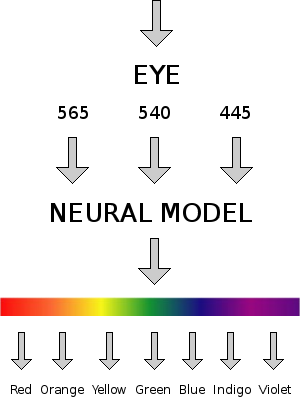 In the diagram on the right, the full visible spectrum of light enters my eyes from the scene (located above the top of the diagram). Sensors in my eyes then detect the light separately from millions of points in the observed scene. The light from each point is sent to my brain as, in effect, three separate signals. One of these signals represents the relative strength of the light in the range of wavelengths centred at about 565nm. Another represents the relative strength of the light in the range of wavelengths centred at about 540nm. The third represents the relative strength of the light in the range of wavelengths centred around 445nm. These signals are not "coloured". They are simply separate signals, each coded with its respective amplitude. My brain then creates a neural network simulation of the scene that is in front of my eyes.
In the diagram on the right, the full visible spectrum of light enters my eyes from the scene (located above the top of the diagram). Sensors in my eyes then detect the light separately from millions of points in the observed scene. The light from each point is sent to my brain as, in effect, three separate signals. One of these signals represents the relative strength of the light in the range of wavelengths centred at about 565nm. Another represents the relative strength of the light in the range of wavelengths centred at about 540nm. The third represents the relative strength of the light in the range of wavelengths centred around 445nm. These signals are not "coloured". They are simply separate signals, each coded with its respective amplitude. My brain then creates a neural network simulation of the scene that is in front of my eyes.
Suppose I am idly gazing out of the window of my study. My consciousness is not paying any particular attention to what my eyes are seeing. My mind is elsewhere. I may be day-dreaming or be deep in thought about the origin of the universe or the solution to social injustice. In this case, the scene will not command the attention of my conscious self. If somebody were to ask me what colour the car was that just went down the road, I could not say. I would not know. I probably would not even be aware that a car had just gone down the road.
Notwithstanding, the neural model of the scene within my brain is continually monitoring the scene in great detail. The neural model of the scene interrupts my current train of thought and takes over my attention only if something out of the ordinary happens such as a loud explosion or a desperate scream. Then, my conscious self — that intangible entity that I know of as "me" — will become fully focused on what the neural model of the scene is presenting to it. On the other hand, my conscious self could simply "take it into its head" to have a break from my current train of thought and have a look at what is happening outside. Again, my conscious attention becomes fully focused on what the neural model of the scene is presenting to it.
 Only now do I become aware of the brilliant colours of a rainbow arching across the city in front of an approaching tropical storm. In all probability, my conscious attention was redirected by a signal from my subconscious as it "silently heard" the rumble of distant thunder. With my full conscious attention now on the scene that the neural model is presenting, I perceive the colours of this beautiful rainbow. But the neural model of the scene does not shine coloured pixels at the "cinema screen" of my consciousness (see the lower part of above diagram). The neural model simply passes nerve signals to the part of my brain that provides the interface with my consciousness.
Only now do I become aware of the brilliant colours of a rainbow arching across the city in front of an approaching tropical storm. In all probability, my conscious attention was redirected by a signal from my subconscious as it "silently heard" the rumble of distant thunder. With my full conscious attention now on the scene that the neural model is presenting, I perceive the colours of this beautiful rainbow. But the neural model of the scene does not shine coloured pixels at the "cinema screen" of my consciousness (see the lower part of above diagram). The neural model simply passes nerve signals to the part of my brain that provides the interface with my consciousness.
The rainbow itself possesses no intrinsic property we can call colour. It is simply emitting electromagnetic waves of different ranges from different concentric strips of its arc across the sky. Neither my eyes nor my brain manipulate signals that contain anything coloured. I was not aware of the colours of the rainbow when I was deep in thought, even though my eyes must have been receiving its light. I only experienced the sensation of colour when my conscious attention was redirected to the scene outside my window.
Language of Consciousness
So why does the "conscious me" perceive colours in this rainbow? What is my conscious experience or sensation of colour? It is my conjecture that my experience of colour is an exclusive property of my consciousness — that enigmatic intangible entity that makes me a sentient being. However, there is more to it. There is a very important corollary to my conjecture.
I think it reasonable to suppose that the perceived brightness of each colour be a direct analogue of the relative strength of each of the respective bands of electromagnetic waves entering my eyes. The analogue conversion and scaling is undoubtedly performed by the neural model of the scene within my brain. On the other hand, my intuition suggests that my experience of each colour must be a symbolic representation of the respective band of electromagnetic waves. The experience of colour must therefore be the result of a process of abstraction performed upon the output of the neural model of the scene by my consciousness.
This means that each colour is a kind of symbol that is used to label a particular range of electromagnetic waves within the visible spectrum. Colour is, however, distinct from other forms of label with which we are familiar in that it is a conscious experience rather than an object like a letter, a number, a word or a piece of cardboard.
At the very bottom of the diagram are the English names of the colours that I perceive in the rainbow. For instance, I perceive the colour under the left-most arrow at the bottom of the diagram and call it "red". The word "red" is an object rather than a conscious experience. I thus here engage in a further process of symbolic abstraction.
The shape or form, or even the spoken sound, of the word "red" bears no analogical resemblance to the conscious experience of colour that it represents. The word "red" is therefore not an analogue of the colour. It is a label that I use to denote the colour. It is a symbolic abstraction of the conscious sensation of colour that is itself a symbolic abstraction of the neural signals invoked by electromagnetic waves, in the range around 650nm, entering my eyes.
I once saw a television science documentary about light. It showed a London bus going round a corner. The bus was red, and that is how it appeared to me throughout the duration of the clip. The small part of the clip where the bus actually turned the corner was then replayed slowly frame-by-frame. The side of the bus in these frames changed from steely blues and greys and dark greens. But there was no red. The bus was clearly seen to be red as it approached the corner and as it continued along the road after having turned the corner.
It seems, therefore, that the experience of colour can be influenced and modified by factors other than electromagnetic wavelength. My consciousness adjusted the colour of the light coming from the side of the bus, based on what I knew the colour of the bus to be, and on the pre-known fact that the paint on a bus does not change colour just because the bus turns a corner. The significance of the visual experience we call red can therefore change with circumstances. Generally, it represents light in a range of wavelengths around 650nm. But in certain circumstances, it can represent light of any wavelength within the visible spectrum. An analogue representation cannot change its significance like this. So again, colour must be a symbolic representation, not an analogue one.
This all lends weight to the idea that colour is part of a fundamental symbolic language that is a property of human consciousness. I therefore venture to suggest that a variant of the famous test for sentience could be: "I perceive colour, therefore I am".
Are My Colours Your Colours?
Colour is a conscious experience of that intangible entity I think of as "me". So, I wonder, do other human beings all have the same colour experience that I do when they are looking at the same thing that I am looking at?
Their eyes are receiving the same signature of intensities and wavelengths of electromagnetic radiation. Their corresponding myriads of nerve channels send the same kind of visual signals to their brains. Their brains are structurally and functionally similar to mine, as determined by our common human genetics. It is reasonable to suppose, therefore, that their brains construct neural models of the scene that are similar to the one that mine constructs. But does this necessarily mean that each of their "conscious selves" attaches the same colour experience to the scene. Does each of them experience the "blue" of the sky the same way I do?
If we each make the secondary symbolic abstraction of the colours in the scene by attaching spoken words to our colour experiences, we can refer to the different colours consistently. One of us could ask, "Which of these flowers do you like best?" Another of us might answer, "I like the violet orchid best". All of us would know exactly which flower he was referring to. But must the violet colour we each see be the same conscious experience for each of us? It does not necessarily follow that it should. It seems to me doubtful that the nature, structure and functionality of an intangible conscious entity should be determined by a physical genetic code.
I think, therefore, I am. But I perceive other beings that similarly appear to think, therefore, they also appear to be. They are conscious entities, like me, with whom I can communicate. I communicate with them through gesture, facial expression, body movement and, above all, through spoken and written language. Through language, I am able to exchange both practical and abstract thoughts with these other entities that are like me. Language allows us to abstract common properties from the elements of the world and thus place them in named (or symbolically labelled) classes. For example, we see that we are all beings of the same kind, with only small individualizing differences. Thus we classify ourselves as human.
We all have almost identical bodies (and brains). Our bodies vary in size by less than a factor of two, generally speaking. Our billions of faces are individually recognizable, but this is only because our brains each have an extremely advanced neural mechanism specially dedicated to recognizing faces. And it only works provided the face it is trying to recognize is exactly the right way up. We even have a common spectrum of social behaviours into which every individual fits one way or another. I think it is reasonable to suppose that all these physical and behavioural characteristics must be determined by our physical genetics influenced by our individual physical and social environments.
I can also understand that it is possible for my personality to be determined the same way. My genetics and my past experiences of nature and society are probably entirely responsible for the way my mind reacts. Though the processes taking place in my brain may be extremely complex, this is no reason to suppose that these processes are not governed exclusively by fixed deterministic physical laws.
Notwithstanding, my intuition is that the "conscious me" is something different. To explain, I need to reiterate an observation.
At times, I (the conscious "me") can "watch" my mind reacting automatically to an external provocation. It acts out endless scenarios that test the world's possible reactions to my reactions in vicious exchanges. Yet, as a conscious observer of such scenarios, I remain quite detached from my mind, my brain, my body and the world outside.
Sometimes, I see my mind being driven by my natural basic instinct. It reacts with blind emotion to an external provocation and drives my brain and body to expedite its desired physical response. On other occasions, I see my mind responding under the control of an acquired mental skill or physical training. It automatically avoids a dangerous encounter in fast traffic or sometimes materializes a finished Java program as if without conscious thought. It can automatically reason out calculated responses, taking into account both tactical and strategic considerations. Yet "I" — the conscious observer — do not actively participate.
But I could participate if I wished. I have the capability of exercising conscious volition to halt the automatic reactions unleashed by my mind, and of taking over deliberate control of the situation. I could say "No, I am not going to react in this emotionally-determined way. I shall respond in the way I consciously choose according to the advice of my conscience with regard to the situation." I am thus forced to conclude that "I" am not my mind. I am something separate.
The property of volition appears to be present in all human beings. Sadly, observation persuades me that all too few of the 7,000 million "me's" on this planet ever exercise this ultimate gift of volition or free-will.
Each "me" is an individual. Nevertheless, it appears to follow after the same mould. Each instance is unique. But all are members of the same class. So, though one's conscious self may not be specified in one's physical genetic code, it would seem to be specified by something equally universal and consistent. Perhaps the structure and functionality of human consciousness is determined by an ethereal "genetic code" indelibly etched upon the fabric of hyper-space. I think it reasonable, therefore, to suggest that everybody's conscious self probably functions in essentially the same way. Consequently, what you experience when you see the blue of the sky is probably exactly the same as that which I experience when I see the blue of the sky.
What About Cats and Dogs?
 A cat's eyes contain the mechanisms necessary to distinguish between the wavelength-ranges that correspond to what humans perceive as different colours. However, cats' eyes don't resolve a scene into as many "colours" as do human eyes. Neither are cats' "colours" as distinct as they appear to humans. Nevertheless, it can be truly stated that, biologically speaking, cats have colour vision. But does this mean that cats experience colour the way humans do? Are they conscious of colour? Perhaps. Can they appreciate beauty in the colours of a landscape or of a butterfly's wings. I think not.
A cat's eyes contain the mechanisms necessary to distinguish between the wavelength-ranges that correspond to what humans perceive as different colours. However, cats' eyes don't resolve a scene into as many "colours" as do human eyes. Neither are cats' "colours" as distinct as they appear to humans. Nevertheless, it can be truly stated that, biologically speaking, cats have colour vision. But does this mean that cats experience colour the way humans do? Are they conscious of colour? Perhaps. Can they appreciate beauty in the colours of a landscape or of a butterfly's wings. I think not.
Cats seem to express certain evidences of consciousness. They can appear afraid. They can seem content. They can also remember. They can categorize other individuals — cats, dogs, people — as friend or foe. Is a cat conscious of its inner "me"? Does it have a conception of self? Has a cat ever said to itself, "I think, therefore I am"? I think not.
 A dog has a somewhat similar vision to a cat when compared to human vision. A dog also expresses certain evidences of consciousness. My uncle once had a dog. My aunt used to give it food that made it fart. After a meal, the dog would lie on the sofa next to my uncle. Terrible smells would pervade the air. My aunt would then scold the dog and order it out of the room. Sometimes the dog would look back at my aunt with eyes that seemed to say "What have I done?" Years later, long after the dog had died, my uncle admitted to me that the majority of the smells were produced by him. It seems that the dog had been "conscious" of the injustice it had suffered.
A dog has a somewhat similar vision to a cat when compared to human vision. A dog also expresses certain evidences of consciousness. My uncle once had a dog. My aunt used to give it food that made it fart. After a meal, the dog would lie on the sofa next to my uncle. Terrible smells would pervade the air. My aunt would then scold the dog and order it out of the room. Sometimes the dog would look back at my aunt with eyes that seemed to say "What have I done?" Years later, long after the dog had died, my uncle admitted to me that the majority of the smells were produced by him. It seems that the dog had been "conscious" of the injustice it had suffered.
This prompts me to speculate that, like me, a dog has a mind that, driven by natural instinct, reacts automatically to external provocation. Its reaction, like mine, may also include the process of reasoning out the most appropriate response, taking into account both tactical and strategic factors.
It may even have a conscious "me" inside watching the reaction of its own mind, although I doubt this. I cannot imagine that the vicious dog, barking rabidly at me through the iron railings of its rich master's urban mansion, has the capacity to ask itself "What is possessing me to react in this ridiculous way to a human passing by on the public pavement, who has passed this way countless times before and has never posed a threat?"
A Conscious Machine?
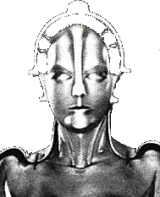 I could conceivably build a robot to respond to a question: "What colour do you see?". For this, I would have to include code within the robot's programming something like:
I could conceivably build a robot to respond to a question: "What colour do you see?". For this, I would have to include code within the robot's programming something like:
if((parsed_speech_input == "What colour do you see?")
&& (dominant_RGB_signal == RED))
speak("I see red, therefore I am.");
I could then add similar snippets of code for each of the colours of the rainbow. Or I could do a neater job by driving a single snippet, like the one above, indexed by a pair of tables — one for parsed questions and one for the corresponding responses.
The robot's correct responses merely indicate that its internal programming is associating the correct pre-stored answer with each question. Its visual sensors are monitoring the intensity of electromagnetic radiation entering its video sensors for each of the three prescribed ranges of wavelength. It is then selecting the answer based on which one of these three signals is the strongest at the time.
However, the robot's correct responses do not mean that it consciously experiences the sensation of colour. It can distinguish between what humans experience as different colours but it cannot itself experience colour.
There is no reason why a robot could not be programmed to respond correctly to questions of an emotional nature such as "Are you happy?". It could even be programmed to give a sensible reason as to why it was or was not happy. The operative word here, however, is programmed. Programming necessitates the existence of a programmer. And a programmer is human. So, if a robot passes a sentience test, it does nothing more than verify that its programmer is sentient.
Conclusion
I conclude that experiences such as light and colour, pitch and tone, bitterness and sweetness, scent and odour, texture, wetness, dryness, heat, cold, pain, eroticism and orgasm are all properties of the consciousness. They are generated in response to physiological events taking place within the brain, but they have no existence there. They have existence only within the conscious entity that every human being thinks of as "me".
I speculate that animals, to a lesser degree, experience these things. However, I do not think that animals can ponder and consider them. Neither can they communicate or compare them. I am sure that machines — however sophisticated they are or may become — experience nothing.
The existence of conscious experience persuades me that the conscious entity that does the experiencing cannot be explained in terms of what is physically perceivable, with or without the aid of scientific instrumentation.
Parent Page | Written 17 March - 11 August 2009 by
Robert John Morton
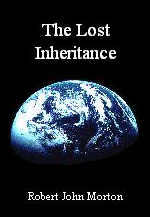
 I further perceive that the composite event that is my life is similarly linked to all other events that are taking place within the physical universe. My life is thus a component event of the universe. I therefore conclude that the physical universe itself is an event. It must be the all-encompassing event that comprises all others.
I further perceive that the composite event that is my life is similarly linked to all other events that are taking place within the physical universe. My life is thus a component event of the universe. I therefore conclude that the physical universe itself is an event. It must be the all-encompassing event that comprises all others.
 Furthermore, molecules, atoms, electrons, protons and neutrons themselves are now thought to be complex dynamical systems in their own right. These must therefore comprise even smaller structures, whose spontaneous changes in velocity or internal configuration precipitate events that are even more basic. I speculate that there must be an indivisible (or unanalysable) event that underlies all others. It is the fundamental constituent of the universe. It occurs when an instance of the fundamental standing wave structure changes into a fundamental travelling wave, which travels outwards from it at the speed of light.
Furthermore, molecules, atoms, electrons, protons and neutrons themselves are now thought to be complex dynamical systems in their own right. These must therefore comprise even smaller structures, whose spontaneous changes in velocity or internal configuration precipitate events that are even more basic. I speculate that there must be an indivisible (or unanalysable) event that underlies all others. It is the fundamental constituent of the universe. It occurs when an instance of the fundamental standing wave structure changes into a fundamental travelling wave, which travels outwards from it at the speed of light.
 I feel sure that my brain is a purely physical device. It is vast. I am given to understand that it is currently thought to comprise about 86 billion neurons It is an immensely powerful information processing engine, comprising massively parallel networks of neurons of various specialised architectures. But since it is physical, the very foundation of its function must involve the initiation and detection of fundamental events. So, are some of these events, that are taking place within the depths of my brain, the essence of my conscious experience?
I feel sure that my brain is a purely physical device. It is vast. I am given to understand that it is currently thought to comprise about 86 billion neurons It is an immensely powerful information processing engine, comprising massively parallel networks of neurons of various specialised architectures. But since it is physical, the very foundation of its function must involve the initiation and detection of fundamental events. So, are some of these events, that are taking place within the depths of my brain, the essence of my conscious experience?

 On the other hand, the coupling between a radio transmitting aerial and a receiving aerial 30 km away is very weak. But it exists. When the receiving aerial captures the signal, it loads the distant transmitting aerial by changing its impedance slightly. It may not be easy or even possible to measure it. But proven theory says that it is there.
On the other hand, the coupling between a radio transmitting aerial and a receiving aerial 30 km away is very weak. But it exists. When the receiving aerial captures the signal, it loads the distant transmitting aerial by changing its impedance slightly. It may not be easy or even possible to measure it. But proven theory says that it is there.
 How are they connected? Is the connection (or influence) one-way or two-way? And how strong (or tight) is this coupling? Does experience absorb the energy of a fundamental event? If so, then assuming that conscious experience be hyper-physical, that energy would exit the physical universe. Does conscious experience induce a reactive load back upon the physical event that invokes it? In other words, does experiencing an event modify that event? The sheer volume of information that is transferred from a physical event to my experience of that event appears to be enormous.
How are they connected? Is the connection (or influence) one-way or two-way? And how strong (or tight) is this coupling? Does experience absorb the energy of a fundamental event? If so, then assuming that conscious experience be hyper-physical, that energy would exit the physical universe. Does conscious experience induce a reactive load back upon the physical event that invokes it? In other words, does experiencing an event modify that event? The sheer volume of information that is transferred from a physical event to my experience of that event appears to be enormous.
 There is clearly no "equal and opposite reaction". Whatever it is that provides the connection between an event and the conscious experience of it, it appears to be a one-way street like an electronic diode, which allows current to flow in the forward direction but not in the reverse direction.
There is clearly no "equal and opposite reaction". Whatever it is that provides the connection between an event and the conscious experience of it, it appears to be a one-way street like an electronic diode, which allows current to flow in the forward direction but not in the reverse direction.
 Some think that the universe has a conscious dimension — a kind of conscious equivalent of space-time. A fundamental event within my brain would thus emit not only a spherical wave of physical energy, but also a hyper-physical wave of conscious influence. So, waves emanating from an experience I am having will travel outwards as a hyper-physical wave. This wave must eventually reach and impinge upon your consciousness, directly imparting to you an experience of the experience I am having, independently of any physical medium.
Some think that the universe has a conscious dimension — a kind of conscious equivalent of space-time. A fundamental event within my brain would thus emit not only a spherical wave of physical energy, but also a hyper-physical wave of conscious influence. So, waves emanating from an experience I am having will travel outwards as a hyper-physical wave. This wave must eventually reach and impinge upon your consciousness, directly imparting to you an experience of the experience I am having, independently of any physical medium.
 The only channel through which human conscious entities can be aware of each other is via the 5 physical senses of their physical bodies acting through the physical world. In other words, I can experience you only via the physical universe. My consciousness cannot communicate with your consciousness directly by propagating waves through a conscious counterpart of the fabric of space-time. Consequently, there must be some sort of mysterious communication interface between fundamental physical events and the conscious entity that I perceive to be "me". And it must be located somewhere within my brain. Perhaps the active elements of this interface directly monitor fundamental events taking place within my neurons or inter-neural pathways. Perhaps my consciousness somehow captures a macroscopic statistical view of a thought. I don't know. Neither do I know the nature of what passes across this communications interface.
The only channel through which human conscious entities can be aware of each other is via the 5 physical senses of their physical bodies acting through the physical world. In other words, I can experience you only via the physical universe. My consciousness cannot communicate with your consciousness directly by propagating waves through a conscious counterpart of the fabric of space-time. Consequently, there must be some sort of mysterious communication interface between fundamental physical events and the conscious entity that I perceive to be "me". And it must be located somewhere within my brain. Perhaps the active elements of this interface directly monitor fundamental events taking place within my neurons or inter-neural pathways. Perhaps my consciousness somehow captures a macroscopic statistical view of a thought. I don't know. Neither do I know the nature of what passes across this communications interface.
 In the diagram on the right, the full visible spectrum of light enters my eyes from the scene (located above the top of the diagram). Sensors in my eyes then detect the light separately from millions of points in the observed scene. The light from each point is sent to my brain as, in effect, three separate signals. One of these signals represents the relative strength of the light in the range of wavelengths centred at about 565nm. Another represents the relative strength of the light in the range of wavelengths centred at about 540nm. The third represents the relative strength of the light in the range of wavelengths centred around 445nm. These signals are not "coloured". They are simply separate signals, each coded with its respective amplitude. My brain then creates a neural network simulation of the scene that is in front of my eyes.
In the diagram on the right, the full visible spectrum of light enters my eyes from the scene (located above the top of the diagram). Sensors in my eyes then detect the light separately from millions of points in the observed scene. The light from each point is sent to my brain as, in effect, three separate signals. One of these signals represents the relative strength of the light in the range of wavelengths centred at about 565nm. Another represents the relative strength of the light in the range of wavelengths centred at about 540nm. The third represents the relative strength of the light in the range of wavelengths centred around 445nm. These signals are not "coloured". They are simply separate signals, each coded with its respective amplitude. My brain then creates a neural network simulation of the scene that is in front of my eyes.
 Only now do I become aware of the brilliant colours of a rainbow arching across the city in front of an approaching tropical storm. In all probability, my conscious attention was redirected by a signal from my subconscious as it "silently heard" the rumble of distant thunder. With my full conscious attention now on the scene that the neural model is presenting, I perceive the colours of this beautiful rainbow. But the neural model of the scene does not shine coloured pixels at the "cinema screen" of my consciousness (see the lower part of above diagram). The neural model simply passes nerve signals to the part of my brain that provides the interface with my consciousness.
Only now do I become aware of the brilliant colours of a rainbow arching across the city in front of an approaching tropical storm. In all probability, my conscious attention was redirected by a signal from my subconscious as it "silently heard" the rumble of distant thunder. With my full conscious attention now on the scene that the neural model is presenting, I perceive the colours of this beautiful rainbow. But the neural model of the scene does not shine coloured pixels at the "cinema screen" of my consciousness (see the lower part of above diagram). The neural model simply passes nerve signals to the part of my brain that provides the interface with my consciousness.
 A cat's eyes contain the mechanisms necessary to distinguish between the wavelength-ranges that correspond to what humans perceive as different colours. However, cats' eyes don't resolve a scene into as many "colours" as do human eyes. Neither are cats' "colours" as distinct as they appear to humans. Nevertheless, it can be truly stated that, biologically speaking, cats have colour vision. But does this mean that cats experience colour the way humans do? Are they conscious of colour? Perhaps. Can they appreciate beauty in the colours of a landscape or of a butterfly's wings. I think not.
A cat's eyes contain the mechanisms necessary to distinguish between the wavelength-ranges that correspond to what humans perceive as different colours. However, cats' eyes don't resolve a scene into as many "colours" as do human eyes. Neither are cats' "colours" as distinct as they appear to humans. Nevertheless, it can be truly stated that, biologically speaking, cats have colour vision. But does this mean that cats experience colour the way humans do? Are they conscious of colour? Perhaps. Can they appreciate beauty in the colours of a landscape or of a butterfly's wings. I think not.
 A dog has a somewhat similar vision to a cat when compared to human vision. A dog also expresses certain evidences of consciousness. My uncle once had a dog. My aunt used to give it food that made it fart. After a meal, the dog would lie on the sofa next to my uncle. Terrible smells would pervade the air. My aunt would then scold the dog and order it out of the room. Sometimes the dog would look back at my aunt with eyes that seemed to say "What have I done?" Years later, long after the dog had died, my uncle admitted to me that the majority of the smells were produced by him. It seems that the dog had been "conscious" of the injustice it had suffered.
A dog has a somewhat similar vision to a cat when compared to human vision. A dog also expresses certain evidences of consciousness. My uncle once had a dog. My aunt used to give it food that made it fart. After a meal, the dog would lie on the sofa next to my uncle. Terrible smells would pervade the air. My aunt would then scold the dog and order it out of the room. Sometimes the dog would look back at my aunt with eyes that seemed to say "What have I done?" Years later, long after the dog had died, my uncle admitted to me that the majority of the smells were produced by him. It seems that the dog had been "conscious" of the injustice it had suffered.
 I could conceivably build a robot to respond to a question: "What colour do you see?". For this, I would have to include code within the robot's programming something like:
I could conceivably build a robot to respond to a question: "What colour do you see?". For this, I would have to include code within the robot's programming something like: